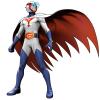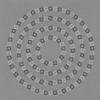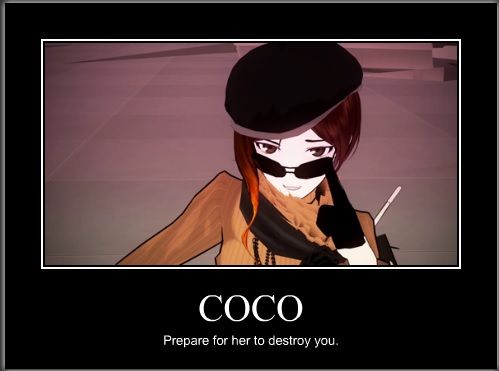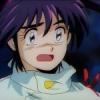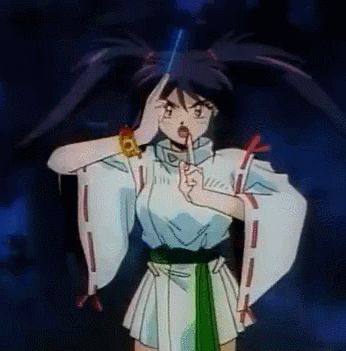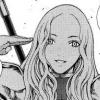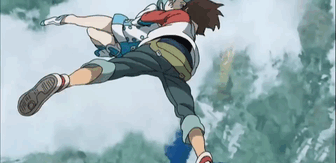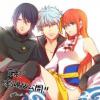I intended getting this post ready for my birthday but it was not possible. Oh, well...
When I think about it, most of 70’s SR anime shows still are widely remembered are shows Go Nagai created (like Mazinger) or was involved with (like Getter Robo or Gaiking), or shows Tomino created (like Gundam) or was involved with (like the Nagahama Trilogy series).
So I am going to go over Tomino shows mainly (the ones have not been recommended already, like Gundam series or Brain Powered), as well as talking about some other noteworthy mecha shows.
But first of all, let’s start with one of the two parents of the genre. I was not going to, but without him –and Astroboy- Mazinger, Getter Robo, Daimos, Gundam, Patlabor, Evangelion, Code Geass, Eureka Seven, Gurren Lagann… would simply not exist.
1945. The Japanese army is developing a super-weapon like a last-ditch attempt to win the war. After twenty-seven failed prototypes, Dr. Kaneda finally completes a giant robot, led by a remote control. He names it Tetsujin 28-go (literally “Ironman 28”).
However, the war is already over, and Dr. Kaneda dies of heart failure shortly after completing his super weapon. Instead of becoming the army’s weapon, Tetsujin is given to Shotaro Kaneda, Dr. Kaneda’s ten-years –old son, who will use Tetsujin to put a stop to criminal activities and destroying evil robots.
Mitsuteru Yokoyama created Tetujin 28-go in 1953, shortly after Osamu Tezuka created Astroboy. The manga is ten-volumes-long and it spawned several anime series along the decades: in 1963 (again, shortly after Astroboy was adapted in anime. It was one of first anime aired in USA, but it was renamed “Gigantor” due to legal issues), 1980, 1992 and 2004. Live-Action and animated movies have been made, and the robot is still so popular in Japan the city of Kobe built a sixty-feet-tall statue of it in 2009.
Tetsujin 28-go is the first giant robot manga ever created. The story is simple, straightforward and optimistic due to a simple reason: Japan had lost WW II nine years earlier. The present was nightmarish and the future was uncertain. People needed entertainment, and series such like Astroboy and Tetusjin 28-go gave them entertainment and fun with the right amount of drama, showing heroes lived through hard times and endured hardships but overcame them with effort, hard work and a never-give-up mentality.
If you watch Tetsujin 28-go, don’t expect most of the tropes associated with humongous mecha shows. They were defined by Mazinger Z (and adopted, ripped off, modified, spoofed, averted, subverted or deconstructed by dozens of later shows), which this show predates by twenty years. So no hot-blooded, teen pilot sitting on the cockpit and screaming his/her lungs out to activate the rocket punch/chest blaster/eye beams/drill for you!
Manga:
Anime: Classic Series:
Classic Series;
2004 Remake
The inhabitants of the planet Zela are facing destruction cause of a black hole menacing their homeworld and mutations horribly deforming the population (their emperor now wears his face upside down. And that is a minor mutation!). Struggling for saving themselves, the Zelans (known like the Dark Horror Army) invade Earth led by Prince Darius.
Opposing them is the crew of the dragon-shaped, semi-transformable carrier Daiku Maryu and the super robot Gaiking, piloted by former baseball star, Sanshiro Tsuwabuki, who was drafted because his latent psychic powers allowed him controlling Gaiking… and because all other potential candidates had been assassinated by Darius agents (and Sanshiro himself had been injured in an attack).
Gaiking was notable because: it was one of the few series happened in real places outside of Japan, and used real Astronomy (well, after a fashion); was the first super robot show featuring a mobile carrier to carry the battle machines; the Dayku Maryu and its support machines were dinosaur-shaped (and actually the head of Daiky Maryu detached itself off the carrier and formed Gaiking’s torso), and all of the alien robots and ships were fish-shaped.
Go Nagai was the original creator of Gaiking, but Toei Animation deliberately took him out of the credits to avoid paying him royalties. The show was created in 1976 and it lasted forty-four episodes. A new Gaiking anime was created in 2005, but it had nothing to see with the first show and rather it was a reimagining.
Curiously, a Live-Action movie is scheduled to be broadcast this year or the next.
Original Anime:
Remake:
Link This is the first mecha anime Tomino ever did:
After a slumber of twelve millennia, the Youma Empire awakens and gets ready to seize Earth. However, Raideen, the ancient protector of the lost continent of Mu, senses the coming of the evil and also awakens inside its pyramid.
Akira Hibiki, a young Japanese boy and captain of the soccer team of his high school, is alerted by a mysterious voice echoing in his head of the existence of the Youma Empire and is led to a pyramid. Then it is revealed he is the last descendant of Mu people, and therefore he is the only is able to pilot Raideen to save the Earth.
Akira accepts to help Raideen to protect the planet, and he is helped by Mari Sakurano, tsundere daughter of a notorious scientist, and his friends of the soccer club.
Yuusha Raideen (Raideen the Brave) was noteworthy for many reasons. It was one of the first transforming mechas (unlike Getter Robo, which was the first COMBINING mecha), and its toy was the first transforming toy. It also was the first giant robot was a sentient machine whose origins were mystic instead of scientific (such like Evangelion or RahXephon. In fact, according the latter’s director, he intentionally and heavily borrowed designs, powers and basic plots to make RahXephon). It was one of the first collaborations between Tomino and Yoshikazu Yasuhiko (the next one would be Mobile Suit Gundam. A funny fact is Char Aznable is based on one Raideen character), and a clear predecessor of the Romance Robot Trilogy (Combattler, Voltes and Daimos).
The anime was aired in 1975 and lasted fifty episodes. A remake was made in 1996 (named Chouja Raideen) and in 2007 (named simply Reideen).
Yuusha Raideen:
Link ;
LinkChouja Raideen:
Link Back in the seventies and eighties, Tomino used to alternate between making horribly depressing stories with a huge death toll and whimsical comedies. After making Zambot 3 (which was awfully depressing and VERY dark) he made Daitarn 3 (which was a gigantic parody of the genre).
Sozo Haran was a brilliant scientist was conducting research on Mars. He created a kind of cyborg –named Meganoid- capable to think for itself. Unfortunately, the Meganoids ran out of control, and killed Dr. Haran and his whole family, except for his sixteen-year-old son, Banjo.
Banjo escapes to Earth on a rocket with a super robot called Daitarn 3, built with special metals of Mars and powered by sun energy. Two years later he is living in a luxurious mansion and fighting together their allies –several of them beautiful women- against the Meganoids who aspire to improve the human race by turning all humans into cyborgs.
Daitarn 3 was a SR genre parody, and it is very noticeable: Daitarn is not merely huge but he is a GIANT giant robot (for a long while it was the biggest super robot). The docking-in sequence was very long on purpose. Banjo Haran is a James Bond spoof –believe it or not- and he is hot-blooded to the max, making dramatic speeches every time his robot transforms, and even telling his father’s ghost going away because he does not need his help to win. The Meganoid monsters had their own personality and frequently engaged in witty banter with Banjo. ..
It was created by Tomino in 1978 and it lasted forty episodes.
Daitarn 3:
Episodes 1-24;
Episodes 25-40 Straight after creating Mobile Suit Gundam, Tomino made this show. Ideon is considered the main influence for Evangelion (geez, Tomino even accused Anno of plagiarizing him) due to dealing with plenty of its issues, its mind-screwing ending and the high count of deaths (certainly Tomino topped himself –and everybody else- here).
The story begins in year 2300. Humankind has begun colonizing other planets.
A group of archeologists researching on the planet Solo discover a large spaceship, called the Solo ship, and the remains of the Ideon: three starfighters can be combined to form an insanely powerful, gigantic robot. Ship and robot are powered by Ide, a source of nearly infinite energy. For three months they worked to restore the giant vehicles unsuccessfully, when a humanoid civilization known as the clan Buff come across them.
And they want the energy Ide.
Several tragic misunderstandings later, a battle between the Earth colonists and the clan Buff begins. Ideon self-activates during the scuffle, and the colonists manage repelling the attack. However it is only the beginning of their troubles. The Terran colonists are forced to flee aboard the Solo ship, chased by the clan Buff who relentlessly and repeatedly attempts get their hands on the Ideon, employing increasingly devastating technologies and weaponry. At the same time, Ideon begins to reveal its devastating and terrific power, and the Solo crew starts realizing noticing it is sentient. Many people dies on both sides during the terrible battles, and the Solo crew ruins their relationships with Earth and all remaining Terran colonies, that want Ideon for themselves.
Towards the end of the series, all armies on the universe are ganging up against the Solo crew. Many members of the crew have –usually horribly- died, and the surviving heroes are feeling how the depression, angst and psychological pressure produced by so many battles and deaths are driving them beyond the limit of the despair, where they are beginning to wonder if they are not Ide energy’s playthings.
But more alarmingly, they notice the Ideon is displeased with the human race and its wars. Actually it is displeased enough to consider to wipe all of them off.
The series ended abruptly. Two movies were made afterwards: A Contact, which was a summary of the series with scenes clipped from the episodes; and Be Invoked, the real ending to the series.
I am hesitant about revealing details of the ending, but it is highly likely if you have heard of Ideon, you know this, and it is one of the instances where it is most blatantly obvious how it influenced Hideaki Anno.
everybody die. And I mean everybody. The universe –or a considerable chunk of it- is obliterated, and every sentient being in the cosmos die and ascend to a higher plane of existence, with mind-screwing scenes included.
However a certain one-shot manga, written by Tomino, seems implying the Universal Century Gundam universe is the Ideon universe reborn, and Juudau – ZZ Gundam main character- is Cosmo’s –Ideon main character- reincarnation.
The anime was made in 1980 and it lasted thirty-nine episodes, followed by two movies like it has been already told.
Generally Ideon generates mixed reactions among mecha fans: the general consensus seems being the show is average, and maybe somewhat dated, but Be Invoked absolutely must be watched if you want seeing how End of Evangelion was made in the old days.
Apparently, Tomino is considering making a remake.
Link:
Anime;
Movies After such an intensely depressing show, Tomino was due to make something hilarious and light-hearted. He succeeded.
The setting is the planet Zola, a desert world inhabited by different human cultures. The two most important are: the Innocent, who master highly advanced science and technology, and live safety in domes; and the Civilians, who live outside the domes and are resilient and strong, but rely on the Innocents to provide them with whatever technology and machinery they need. That technology includes the walker machines (vaguely humanoid vehicles used for mining, trading, building and even combat) and ships they use to journey across the desert plains.
The Innocents use their contacts with Civilian groups to keep them at odds with each other and so maintain their positions of power. Likewise, they have decreed any crime committed among the Civilians is forgiven if the perpetrator isn’t brought to justice in three days.
Jiron Amos -whose parents were murdered by Breaker Timp Shaloon a week ago- is not about let such a silly thing like a time limit get between him and justice. He and his new friends, the Sand Rats bandits, find a very rare, combat-oriented, Xabungle-type walker machine and decide “liberating” it for achieving his goals.
Eventually, Jiron’s quest for punishing Timp evolves into a crusade against the Innocents rule caused this whole mess.
Xabungle is an utterly mad comedy, full with light-hearted humor and charming characters. It was created in 1982, and it lasted fifty episodes, spawning a movie.
Link:
Anime Once again, after creating a light-hearted comedy, Tomino made again a dark, grim anime where anyone can –and does- die (and it was a predecessor of Vision of Escaflowne):
Sho Zama, a Japanese motocross fan, falls in the world of Byston Well after a vehicular incident during a trick. Byston Well is a fantastic world, located in another dimension between land and sea, populated with dragons, fairies and other fantasy creatures, with kingdoms ruled by monarchs living on castles, armies of unicorn-riders armed with swords and bows, and humanoid, insect-like mechas named Aura Battlers.
Sho is taken in by Drake Luft, a local lord, and is taught to pilot an aura battler. His new life seems being going well, until he meets with Neal Given, leader of the local resistance, who shows him Drake is not quite a benevolent, kind ruler. Sho then decides joining the resistance, using his aura battler, named Dunbine, to fight alongside them.
Dunbine stood out in the time for its unique blend of robot and fantasy genres, setting battles between humanoid robots (which were designed with organic, very distinctive shapes) in a medieval landscape (fifteen years before Vision of Escaflowne), and for its explosive final.
The show was created in 1983, and it lasted forty-three episodes. It was followed by a three-part OVA series in 1988.
Link:
Anime;
OVA
The story takes place in the Pentagona System, a solar system made up of five planets. Oldna Poseidal, emperor from the planet Gastogal leads a campaign of conquest throughout the entire system, until he has seized all planets on Pentagona.
Finally he completes his conquest by defeating Kamon Walha V, leader of the Yama Clan and ruler of the planet Mizum. However, Kamon manages hiding his heir, Kamon Myroad, and the legendary robot, L-Gaim on the planet.
Fifteen years later, Kamon, who now names himself Daba, journeys over the wastelands of the planet Koam,as he leads a rebellion to free Pentagona from the Poseidal’s rule.
Heavy Metal L-Gaim was created in 1984, and it was fifty-four-episodes-long, spawning a 3-episodes-long OVA series. Mamoru Nagano –who later created The Five Star Stories- was the character and robot designer.
Link:
Anime I was not going to mention the next one because I think it is a pretty minor series, but I decided adding it for a simple reason: It is a Reiji Matsumoto’s work.
In the future, Earth has been nearly depleted from its natural resources, and humankind is seeking a new home on other planets, mainly in Promete, a planet beyond Pluto. However the first explorers are destroyed by betrayal, shattering the hopes of settling peacefully in that world.
Shortly after, an individual called Mr. Doppler leaves toward Promete and declares himself Chancillor of the planet. Believing only he is entitled to it, gathers an immense army using the planet’s sources, and forbids anyone from approaching the planet.
To regain control of Promete, the Earth governments build up a fleet of giant robots, but Doppler attacks before they can de deployed and he destroys all of except the robot named Danguard Ace. The forces sent to attack the base where it was being constructed were destroyed by Captain Dan, a mysterious masked man whose past is unknown, except he served for a while Doppler under mind control.
Takuma Ichimonji, son of the man who betrayed the Promete exploration team, becomes a member at Danguard’s base, hoping he could restore his father’s honor by fighting Doppler and his army.
Wakusei Robo Danguard Ace was created by Reiji Matsumoto in 1977. The anime lasted fifty-six episodes.
I have heard Matsumoto made Danguard Ace only because he needed the money, since he hated super robot shows (and even then he avoided drawing the robot if he could). I do not know if it is true; still, he made a good work.
Manga:
Link:
Anime Other noteworthy mecha series not made by Tomino are:
In the year 2065 the world is divided in two countries that are at constant war over a device named the space elevator.
One of them decides to launch an attack to blow it up, using a dimensional super weapon: the Space/Time Oscillation Bomb. Kei Kutaragi and his friend Olson are assigned to the strike squad must escort to the engineers must arm the bomb on-site. However, the operation fails, and Kei, enraged, decides arming the bomb… with catastrophic consequences.
The weapon goes off, and he gets caught in the blast. Kei faints and later he wakes up in a strange land, where he is found by a humanoid race of traders named Emaan. At the beginning he thinks he is in another world, but later he is informed that planet IS Earth, but an Earth was born when the dimensional bomb exploded, sending space and time in chaos and squashing together the Earths of different alternate dimensions.
That world is populated with many kinds of races and clans. Two of those tribes (the Emaan and the militaristic clan named Chilam) are interested in Kei by some unknown reason, referring to him as Tokuiten (“Singularity Point”).
Kei joins the crew of the Emaan flying ship, Glomar, and they repair his damaged fighter, modifying it and naming it Orguss so Kei can defend himself and themselves of the assaults of the Chilam, who are determined to get their hands on Kei.
Choujikuu Seiki Orguss/Super Dimension Century Orguss was created in 1983 and it was the second show in the “Super Dimension” series (the first show was Macross and the third one was Southern Cross. In fact, Orguss was supposed to be part of Robotech, an amalgamation of three different anime shows -Macross, Southern Cross and Mospeada- made for the American market). It lasted thirty-five episodes, and it got a sequel ten years later: the six-episodes-long, OVA series, Orguss 02.
Even though it is not so popular like Macross, Orguss was more imaginative, and it had nice character and mecha designs and cool aerial fights.
Link:
Anime;
OVA
A young and beautiful girl named Mia Alice wakes up in a space station. She is confused, frightened and she has forgotten all but her name. Then a strange voice tells her she has been abducted and transformed into a cyborg due to she wields powerful psionic skills, and she and other three people, alongside the super robot Dangaioh, will be sell out as soldiers to the higher bidder.
However, Mia doesn’t want being a super soldier or piloting a giant robot. She only wants being a normal girl. And she has not completely lost all of her memories. She remembers vague hints of her past life…
Soon she meets the remainder candidates to pilot Dangaioh: Roll Kuran, Pai Thunder and Lamba Nom. All of them have got their memories wiped out and wield great psionic powers (but Pai, but she is strong and aggressive enough to compensate for that lacking). The four of them decide to team up to attempt recovering their freedom and fighting their common enemy: their potential employer, Captain Garimoth.
Dangaioh was pretty cynical and little idealistic for a super robot show. The story is rather dark, the past lives of all characters come back to bite all of them on their collective butts, and the ending was bittersweet and very open-ended. Some of the best Anime-makers in the eighties worked on it (Toshihiro Hirano, Shoji Kawamori, Hideaki Anno, Masami Obari…) and it is pretty well-loved among older mecha fans.
The show was a three-part OVA series made in 1987. A sequel –Great Dangaioh- was made in 2001, but it flopped, lasting only thirteen episodes.
Link:
OVA;
Sequel The year is 1997. Evangelion has brutally deconstructed the genre. But it has also revitalized it, bringing many classic robot shows back, and inspiring many new series. In the wake of all it, a show was made to reconstruct the genre, bringing back combining mechas and hot-blooded pilots driven by courage, friendship and sacrifice, screaming out their robot’s attacks.
Later years of the twentieth century. A married couple is driving in the middle of a snowstorm when they are stopped by a kind of mechanical lion which appears out of nowhere and delivers a baby to them before leaving. They are completely shocked but they take the child in, naming him Mamoru.
Eight years later Mamoru is on a class trip to a garbage island to learn the importance of recycling when a giant monster arises and starts trashing the city. Mamoru and his friends are trapped inside the beast, and their future seems dire when the army begins bombarding the behemoth… only to be blasted away with extreme prejudice.
All hope seems lost, when a red-haired, half-cybernetic young man (Guy Shishio) dashes in the battlefield to save them and stop the monster. Successively he tries to use his own augmented physical skills, a bullet train, a stealth bomber and a drill tank. When it doesn’t work, he leaps into the robotic giant lion from eight years ago, that morphs into a humanoid fighter. And when it is yet not enough to win, he fuses the four vehicles together to form Gaogaigar, King of Braves.
Next he delivers a rotund trashing to the giant monster, ripping its core from it with his bare hands, but right when he is about of smashing the glowing, pulsating orb, Mamoru begins glowing green, light wings spread from his back, and he flies towards Gaogaigar, begging him not destroy the core.
And that is only the summary of the first episode!
The beginning of the show followed the good, old monster-of-week formula, constantly introducing new characters, technology, plots or background details to keep the things fresh. Later, the plot ravels and Gai’s fights get harder and tougher, and he needs all his intelligence, expertise and guts just to survive each battle.
Yusha Oh Gaogaigar/King of Braves Gaogaigar is the seventh and final installment of the Brave Series (a Takara/Sunrise franchise of Super robot Series started in 1990). It is also the most popular one. If Evangelion was a deconstruction, Gaogaigar was a reconstruction: a good, classic-style super robot show with awesome fights and a pretty good plot. It is a solid and entertaining show.
It was made in 1997 and it was forty-nine-episodes-long. It got a six-episodes-long OVA sequel, Gogaigar Final, and it nearly got several sequels.
Link:
Anime;
OVA;
Alternate Sequel That's all for now.


